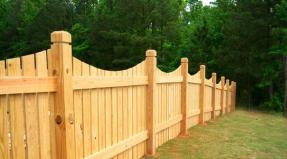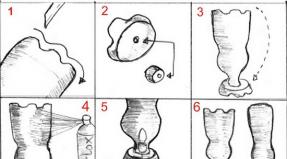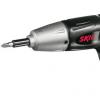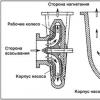Installation of electrical distribution board
The electrical network of a house or apartment is not only wires, sockets, light bulbs and switches. The more complex and most important part of the electrical circuit is considered electrical panel, which contains circuit breakers, RCDs, difavtomatov and additional equipment. Exactly at electroshield the control unit for all electrical facilities is located in a separate area. Until recently, there were no electrical panels in the apartments. It was considered sufficient switchboard which is located on the landing. An electric meter and a couple of automatic machines relied on a separate apartment.
However, sometimes the meter was located in the apartment and with it - two fuse plugs. However, progress does not stand still, energy consumption has increased several times, and safety requirements have changed. Suffice it to say that 30 years ago, consumption per apartment was limited to 800 watts. Compare this figure with today's energy consumption. One electric kettle consumes 1.5–2 kW, not to mention washing machines, microwave ovens, air conditioners, etc. It is clear that, along with increased energy consumption, the requirements for electrical equipment have also changed.
Before embarking on electrical work, it is necessary to draw up a diagram of the apartment electrical panel, indicate what will be in it and how to connect it. When implementing such a scheme, the following factors must be taken into account:
1. Wiring type in the apartment: "star", "loop", in junction boxes or a mixed version. The choice of wiring depends on how many wires will fit the shield. Their number can vary from one to several dozen.
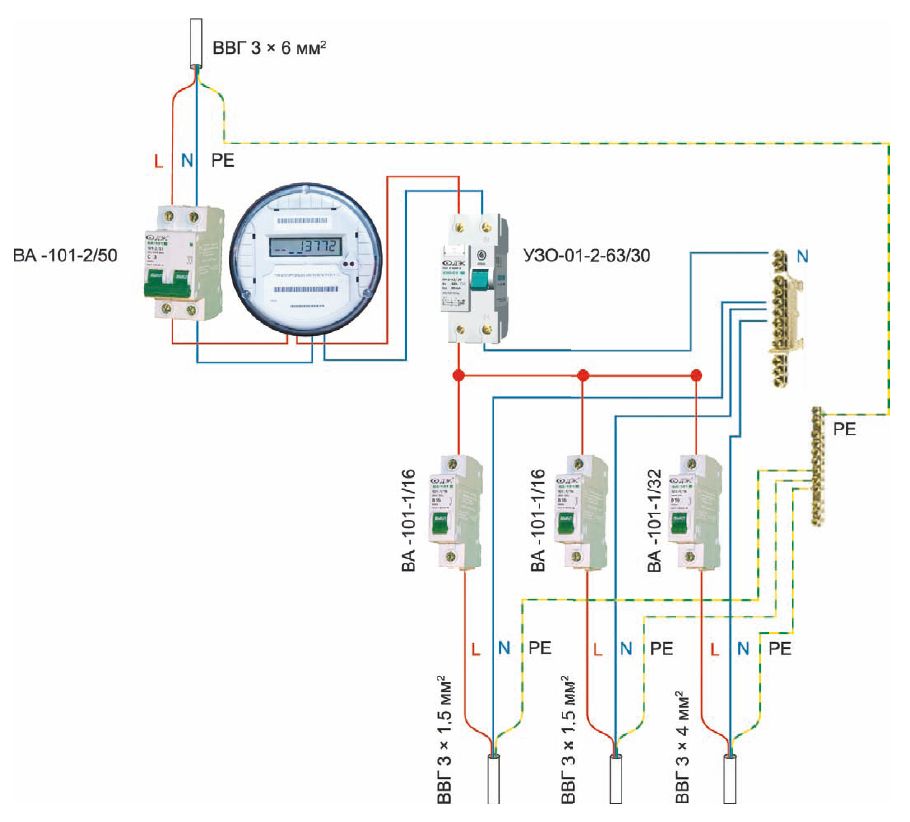
2. total power all electrical appliances in the apartment and separately the power consumption in a dedicated area. These values must be calculated in order to determine the nominal values of the machines.
3. Consider all load options, for example, guests arrived and literally everything that is possible is included in the apartment: a stove, air conditioning, a computer and even a washing machine. If such calculations have already been made (you have determined the cross section of the conductors), then it will be easier - automatic machines and other devices are selected for the cable. When it is designed for a current of 25 A, which corresponds to a cross section of 2.5 mm² of a copper core, then the machine or RCD should be 16 A.
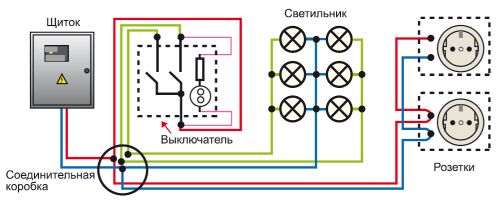
4. What type of electrical appliances installed in the apartment. Remember that RCDs must be installed on individual devices (for example, washing machines).
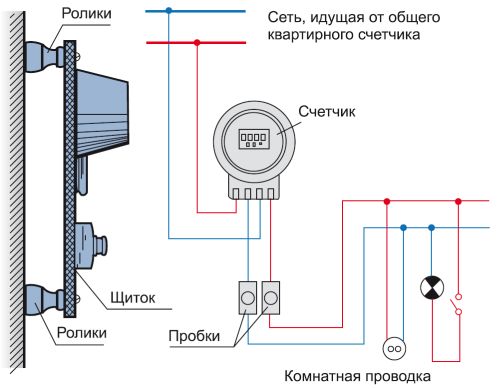
To better imagine sequence of actions for installation of apartment electro shield, we will give an example of setting a specific scheme. In front of you is a two-room apartment.
It is known which devices will be in it and the number of separate zones, a diagram of the electrical panel has been drawn up. Installation begins with the choice of the location of the shield, its size and type. The shield, as a rule, is located in the hallway near the front door. This is the most rational - you do not have to pull the incoming cable far. Although this condition is not strict, you can put an electrical panel in the back room.
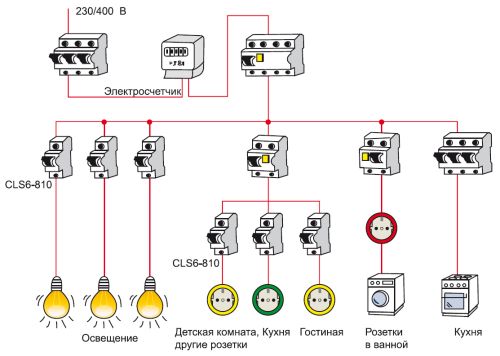
Diagram example - apartment wiring, three-phase
It is located at a height of 1.5 m or at eye level, so that it is convenient to reach it with your hand. If there are children in the house, it makes sense to install the electrical panel higher and choose an option that is locked with a key, such as a metal SHRV.
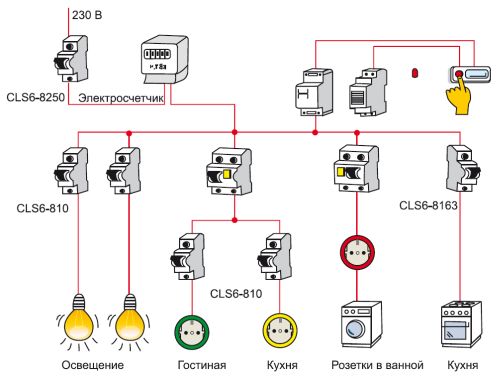
Diagram example - residential wiring, single-phase
View electro shield: outdoor or indoor installation, plastic or metal, with a transparent door or not - depends on the ease of installation and your preferences. For example, it is most convenient to install a built-in shield in plasterboard partitions, and outdoor installation on reinforced concrete walls. You do not have to gouge a recess under it in the wall, which is very laborious.
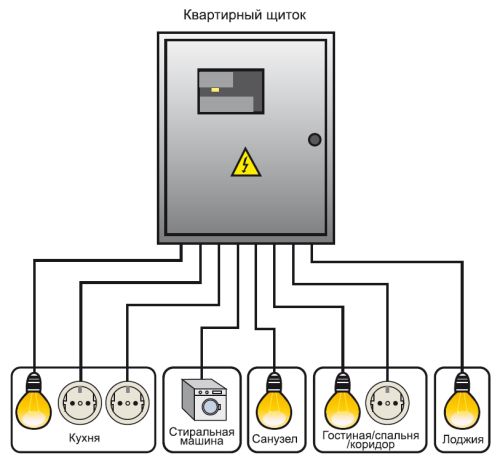
Switchboard size depends on the number of devices that will be located in it. There are approximately 30 poles, or modules, in the above diagram. One single-pole circuit breaker occupies one module. All electrical devices that are located in the shield have dimensions that are multiples of the width of this module. For example, a counter can occupy a place equivalent to the place of 8 machines; to install it, you will need a box for 8 modules. By counting the number of machines and the dimensions of other electrical devices, you can find out what size shield is needed. You don’t need to go to the store with a ruler at all. Shields are called like this: for 12 modules, 36 modules, etc.

There are many types of them. In our case, you need a box for 36 modules. There are those inside which there may be places for a counter and separately for machines and other devices attached to a DIN rail, or only for mounting on a DIN rail. Lots of options. To select the right shield, you need to make a list of all the equipment that will be installed inside, and consult with the seller in the store.
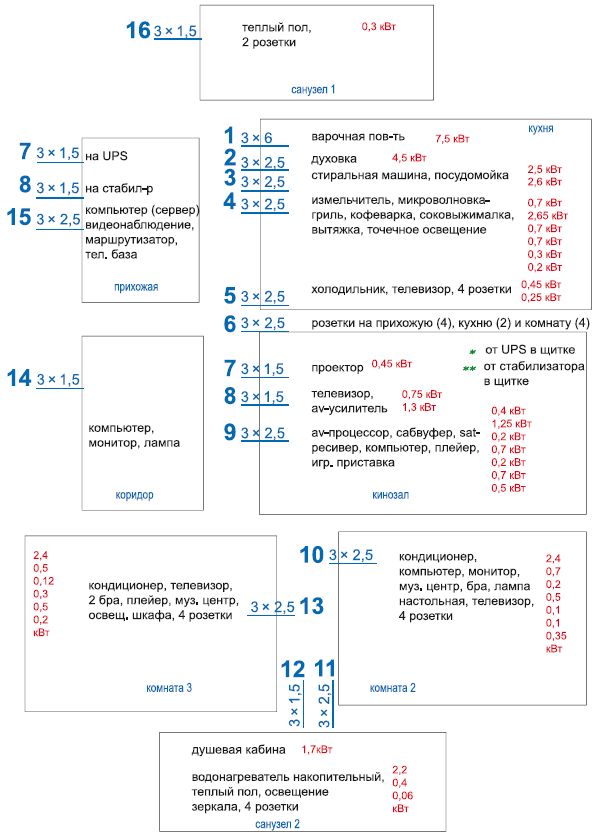
If a electroindoor installation shield, then to bring a large number of wires to it, wide strobes are hollowed out that can accommodate a bundle of cables. For outdoor - boxes of appropriate size or a sufficient number of plastic pipes. For the introduction of wires inside the plastic switchboard, there are holes on the side panels around the perimeter, covered with break-out hatches. There are ready-made holes in the metal shield: at the top - for incoming cables, at the bottom - for outgoing ones. The wires at the entry and exit points of the shields in such boxes are protected by glands or couplings. If a metal box with a sealed lid, then the installation of couplings is required.

Outer electro shield fastened to the wall with dowel-nails or screws. The inner one can also be attached to the back cover and additionally grabbed along the edges with plaster glue or alabaster. After the shield is installed in place and the wires are inserted into it, the turn of the electrical installation equipment comes. Inside any box there are special pins for attaching a DIN rail. Meters can be mounted on this rail or a special place inside the shield on the usual fasteners: screws or screws.
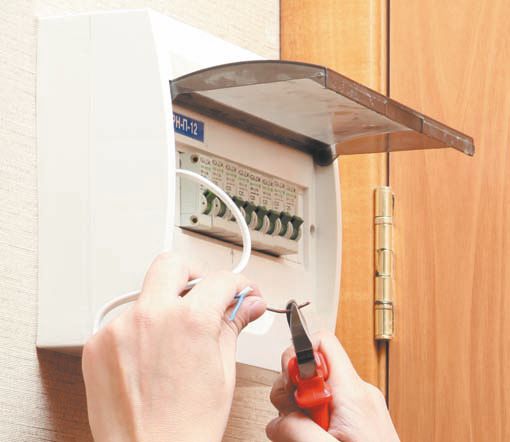
Very easy to install: it is enough to insert them on the DIN rail until they click - and the device will be securely fixed on the bar. To remove or move the machine, it is enough to push its eye with a screwdriver - the device will be removed from the mount. The electrical panel, which is suitable for installing the devices shown in our diagram, has 3 DIN rails of 12 modules each. An input two-pole machine for 40 A is placed on the first bar from the top on the left. Phase and zero are connected to its two poles, respectively. The machine will show symbols indicating which conductor to connect to what. A counter is installed next to the machine to the right of it.
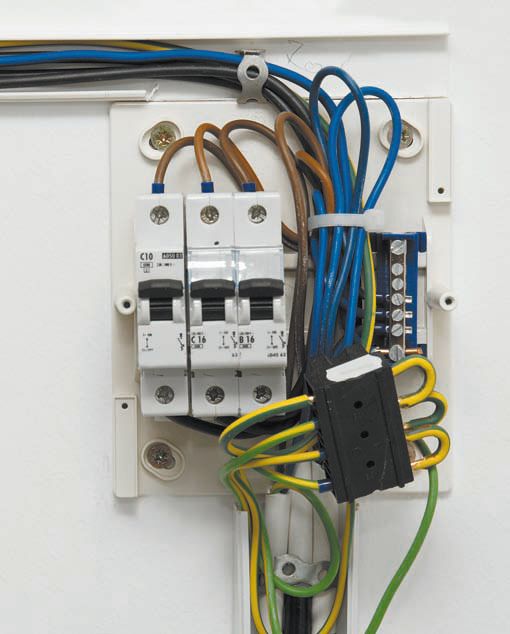
Note. Devices in the shield can be placed in any order - it does not matter, as long as they are connected to each other correctly. However, it is much more convenient when they are arranged one after another in the same sequence as in the diagram.
If you do not have permission to install, then you should not connect the shield - a specialist will do this. In the case when you nevertheless connected it yourself, you need to show the shield to the electrician on duty, who will check everything and put seals on the meter.
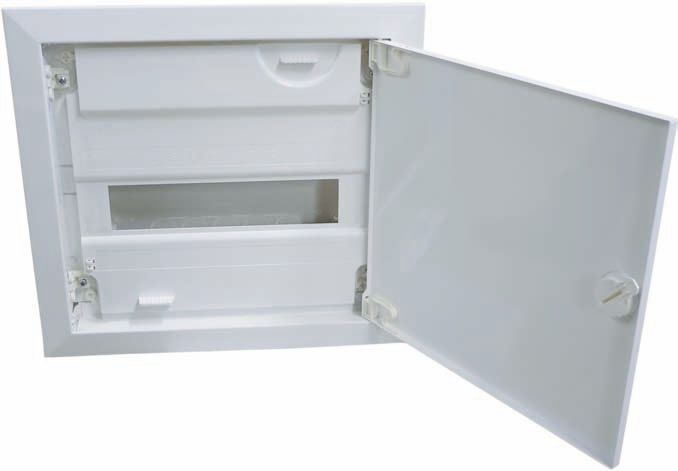
Note. It is not possible to consume more energy than indicated on the meter. What kind of counter will stand on the apartment, the organization (Housing Office) chooses. For example, if it is written on the device that it is designed for 5–40 A, then it will be impossible to consume more than 8.8 kW. The counter will just turn you off.
Immediately behind it is a 40 A bipolar machine, similar to the one installed in front of the meter. In truth, this automaton is an obvious search, it simply duplicates the work of the first VA. However, if you want to play it safe, you can put it. The place on the first DIN rail is over, now you need to move on to the middle one. The voltage relay is installed first on the left on the middle shelf. This is such a tricky device that monitors the extreme values \u200b\u200bof the voltage and keeps a record of its throws. In fact, it duplicates the work of VA, breaking the circuit if the current suddenly starts to rise or fall above or below the set values. In addition, the relay shows exactly when and how much the voltage has changed. This additional control device is optional, but very useful if expensive electronic equipment is installed in the apartment.

Next in line is RCD. After the voltage relay, the common line is divided into 3 zones, each of which is controlled by one RCD. Since the machine in the circuit in front of this device is designed for a rated current of 40 A, then the RCD is set with the same indicator. The response threshold for all such 3 devices is 30 mA, which, in principle, is normal. However, the RCD, which is responsible for the bathroom, is best set with a threshold of 10 mA. You should not install one such device to connect the oven and washing machine with a water heater in the kitchen. It is better to break these devices into different RCDs. The middle DIN rail is busy, now you need to go to the bottom one. The entire lower bar is occupied by single-pole VA. There are only 9 of them, so there is enough space in abundance. Each of these automata is responsible for a certain part of the circuit.
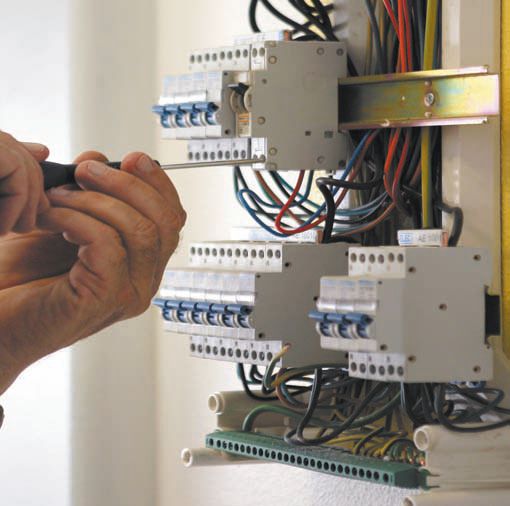
For example, the first and second from the left stand on 2 groups of outlets in the kitchen. This is correct, since the kitchen is the most powerful consumer, it houses a lot of electrical appliances. 2 more machines control the power load in the bathroom, as it houses serious power equipment: a water heater and a washing machine. These devices are connected not through sockets, which should be less in the bathroom, but through junction boxes and terminals. The last 2 machines in a row of 10 A each are set to lighting, which is divided into 2 zones: living rooms and other premises - a bathroom, a kitchen, a corridor and a toilet.
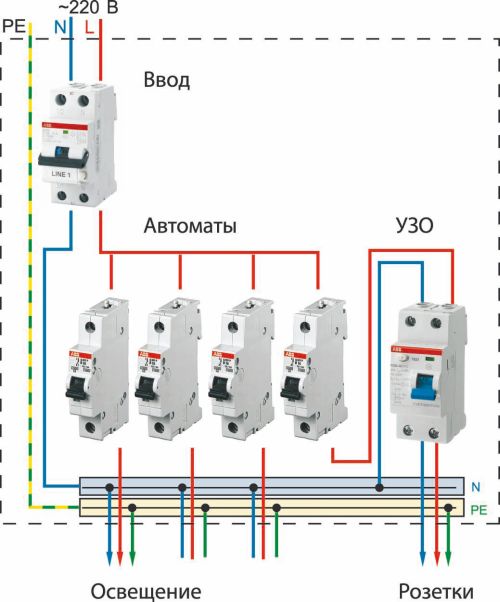
The diagram shows that there is a two-pole machine at the input. Then the apartment network is divided into 2 main zones: lighting and power. The RCD and the automatic device in front of it protect the power zone, it is additionally divided into 3 parts and the RCD does not control the lighting zone. After the machines and other devices fall into place, it is necessary to connect them to each other and to the network. Such a connection occurs only when the incoming cable is disconnected. You should start with the fact that 2 tires are installed inside the shield on special stands, which must be used without fail. In a plastic or metal box, such tires are installed in a free space on insulating stands. These tires serve to connect together zero and ground conductors, since all equipment after the RCD is connected together only by phase conductors.
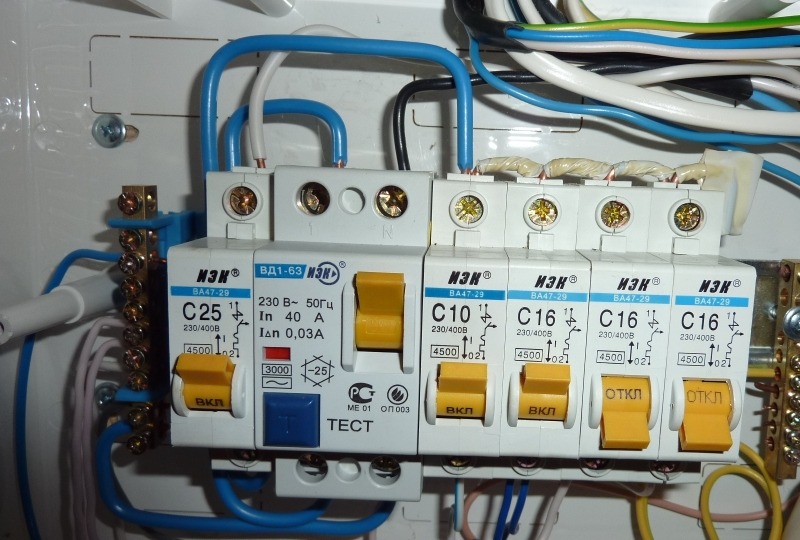
The busbars should be loose so that there is room for suitable wires. It is necessary to select a bus according to the number of wires suitable for it. In this case, it is better to choose a tire with 14 holes in order to have 2 in reserve. It is best to connect the devices to each other using single-wire cores, since they are well fixed in place and do not require special lugs to be installed on the bare part. To connect the poles of the machines to each other, you can use a special single-pole bus-comb; if not, then just twist the wires.
It is not difficult to connect electrical devices if you carefully read the diagram and take your time with the connection. It should be noted that the 2 wires on the far right in the diagram, responsible for lighting, do not have ground wires. If there are no fluorescent fixtures with a ground contact, this is normal. When available, you will have to put a three-wire wire on the lighting and connect the ground conductor to a common ground bus.
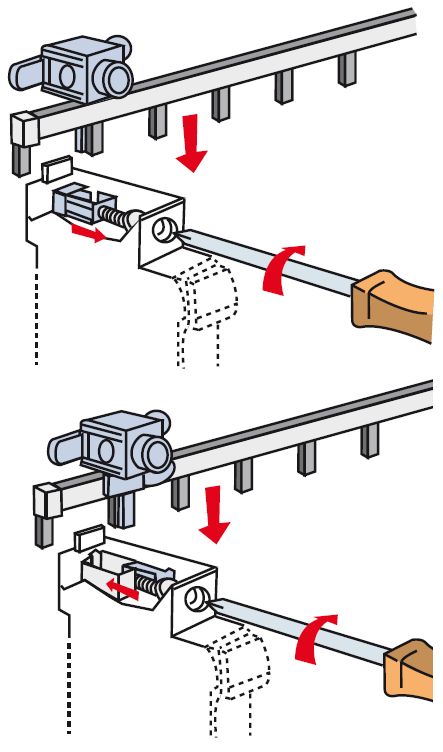
After the equipment is interconnected, the incoming cable and the wires going to the power zones are connected. The last step: sign each machine - what exactly it refers to. There are special boxes for this. If there are none, then the inscriptions are made on the plastic cover of the shield, which covers the inside of the box. The final touch is the inclusion of an apartment electrical panel. After that, you need to check the power on all wires using the indicator.
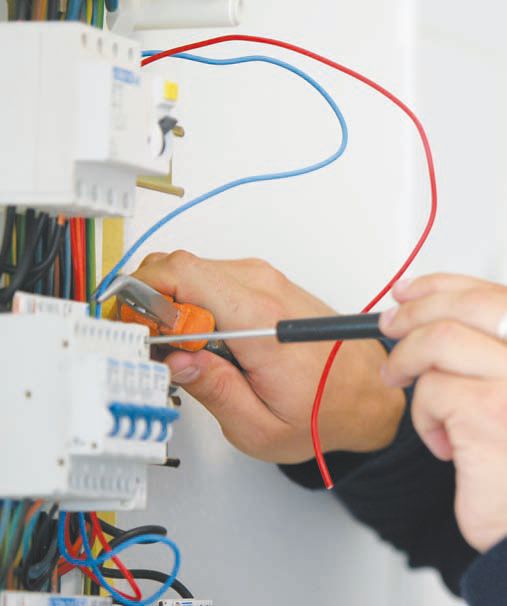
- You should always purchase a slightly larger shield for several groups. If there is a need to install additional equipment, then you do not have to change it.
- You should not combine several electrical appliances of different purposes under one RCD, otherwise it will turn out that a hair dryer will break through in the bathroom, and the computer will turn off in the living room. It is better to divide the zones geographically: a bathroom with a toilet, separate living rooms, a kitchen.
- It is better to install an RCD after the machine according to the scheme, and it should be one step higher in terms of the rated current. For example, a pair of VA / RCD should be like this - 16 A / 25 A. After all, the RCD does not respond to a short circuit. This should be done by the machine, so it is better to choose a higher value for the RCD so that it does not burn out. You can put equal values, there will be no big error.
- If the RCD protects several machines in a row and stands in front of the machines according to the scheme, this is a violation. At the same time, in front of the RCD there is usually an introductory circuit breaker (or maybe more than one). This is prohibited, more precisely, not according to the rules of energy supervision. According to this organization, a VA machine should be on the incoming cable, then a meter, and only then an RCD. You can put a difavtomat in front of the counter.
- The best solution would be to put an RCD on each zone after the machine. However, looking at the prices, you have to combine several machines under one RCD.
- Do not put RCDs and difavtomatov on sockets to which the computer will be connected. This tricky device can cause false triggering of devices, especially if the trigger threshold is not calculated.
- It is better to purchase a mechanical RCD, rather than an electronic one - it is more reliable and does not depend on the operation of the network.

apartment electro shield is not the only problem a home electrician may face. After all, there is also storey electrical panel, in which, in theory, it is impossible for a home master to host, but sometimes it is necessary. It is unlikely that you will have to install such a switchboard, but if you seriously take up the modernization of electricity in the apartment, then you cannot leave it unattended. There will be no big use in ultra-modern equipment inside the apartment if the power cable in the switchboard is made of aluminum of retirement age, and the only 25 A package switch controls the power supply, obviously not the latest model.
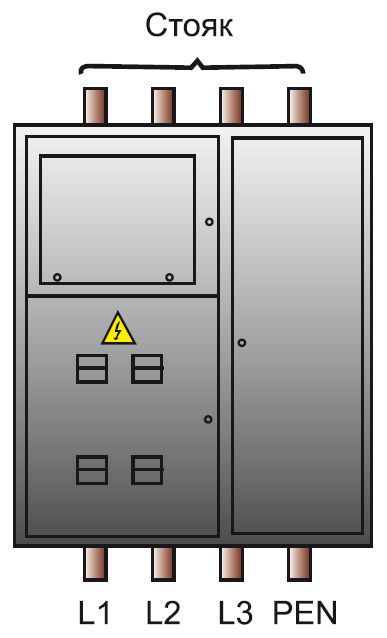
Let's figure out what happens in the switchgear, which, as a rule, is locked, and the electrician on duty has the key. This is a wiring harness from one supply electrical panel for several apartments. The principle is the same as that of the water supply - one riser per entrance, from which there are branches to each user. True, electricity then returns in the form of zero, and the water supply ends with a sewer. You should immediately warn: if there is no access to the shield, then you should not climb into it, unless the machine cuts off the electricity and you will need to turn it on again. All work must be done by an electrician from the Housing Office.
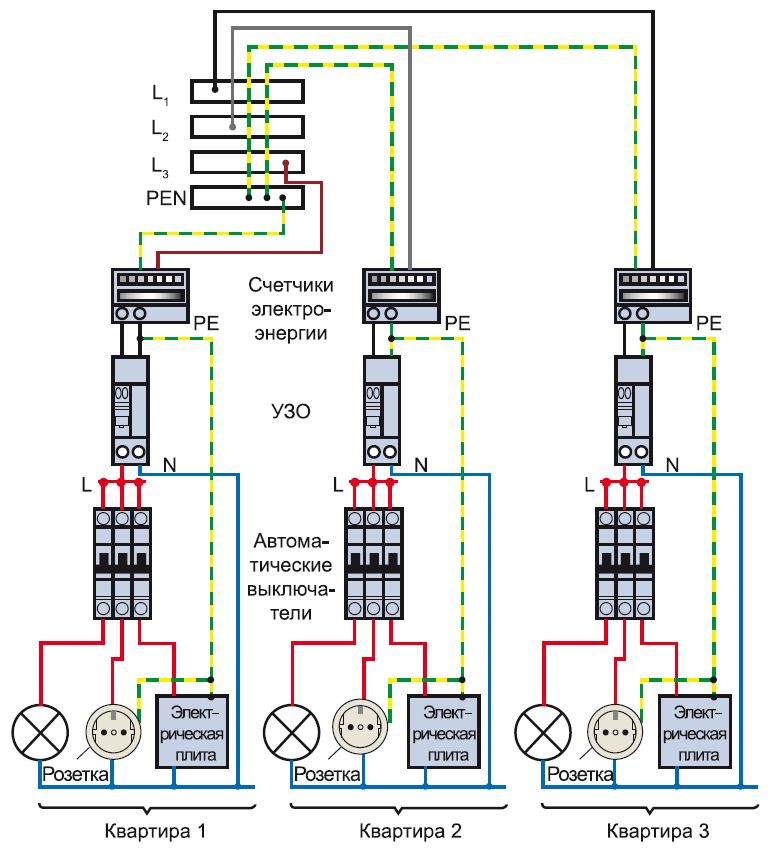
The only thing that can be achieved is to buy materials and achieve modernization from the Housing Office. The electrician will do and you will watch. ShchE must correspond to the apartment shield, if not in terms of equipment, then at least in terms of power and reliability. Inside the shield there is a picture that will make anyone horrified. These are tangled bundles of wires of an incomprehensible section, connected together in a variety of ways, half-decayed insulation, dilapidated automatic machines in cases covered with cracks. All this is neatly covered with dust, causing nostalgia (or allergies) for Soviet times.
As a rule, it is impossible to figure out which cable belongs to what - there are no tags and inscriptions on them. The cable leading to the apartment is detected by long experiments to turn off the input machine and by poking a probe at all contacts or approximately guessing in direction. You can do this: draw up a diagram of what exactly needs to be done, buy materials and agree with an electrician on the work to be done. It is best to cooperate with neighbors to remake the entire shield.
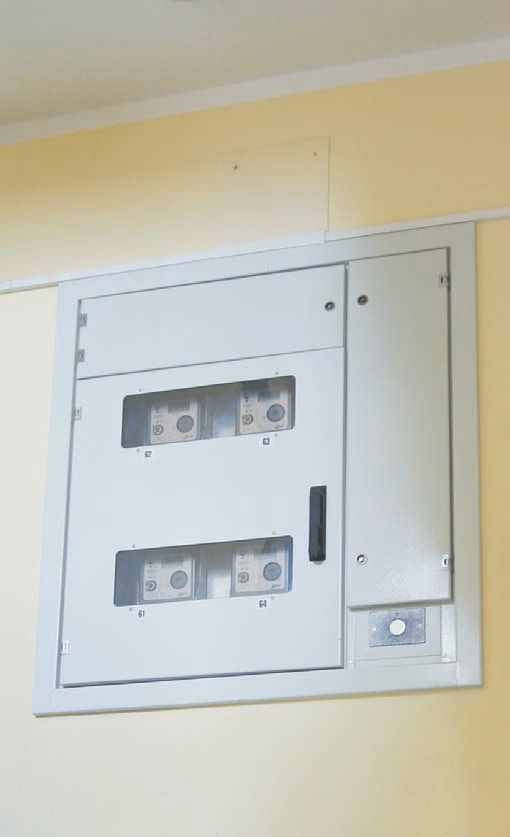
Necessary actions:
- 1. Replace the cable leaving the riser with a copper cable of the appropriate section. In this case, it is necessary to connect the aluminum cable of the riser to the copper outgoing cable using a special terminal or clamp.
- 2. Replace the old AE or package switches with modern automatic switches suitable for amperage, which must be put on a DIN rail.
- 3. If neutral and ground wires are attached to the ground bus and common zero using old connectors, then it is better to replace them with newer and more modern ones.
There is another way how to radically replace all the equipment in storey electrical panel. If the counter is moved to apartment electrical panel, then in the floor you can put a knife switch with fusible links or even without them. The main thing is that the Housing Office should agree with this.

